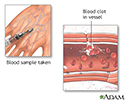Drug-induced thrombocytopenia
Drug-induced thrombocytopenia; Immune thrombocytopenia - drugThrombocytopenia means that there are not enough platelets. Platelets are elements in the blood that help the blood clot. A low platelet count makes bleeding more likely.
Thrombocytopenia
Thrombocytopenia means there is an abnormally low amount of platelets. Platelets are parts of the blood that help blood to clot. This condition is ...
Many conditions can cause a low platelet count. When medicines or drugs do this, it is called drug-induced thrombocytopenia.
Causes
Drug-induced thrombocytopenia occurs when certain medicines destroy platelets or interfere with the body's ability to make enough of them.
There are two types of drug-induced thrombocytopenia: immune and nonimmune.
If a medicine causes your immune system to produce antibodies which seek and destroy your platelets, the condition is called drug-induced immune thrombocytopenia. Heparin, a blood thinner, is the most common cause of drug-induced immune thrombocytopenia. This is a unique form of drug-induced immune thrombocytopenia that increases the risk of blood clots.
Antibodies
An antibody is a protein produced by the body's immune system when it detects harmful substances, called antigens. Examples of antigens include micr...

If a medicine prevents your bone marrow from making enough platelets, the condition is called drug-induced nonimmune thrombocytopenia. Chemotherapy medicines and a seizure medicine called valproic acid may lead to this problem.
Chemotherapy
The term chemotherapy is used to describe cancer-killing drugs. Chemotherapy may be used to:Cure the cancerShrink the cancerPrevent the cancer from ...

Other medicines that may cause drug-induced thrombocytopenia include:
- Furosemide
- Gold, used to treat arthritis
- Nonsteroidal anti-inflammatory drugs (NSAIDs)
- Penicillin
- Quinidine
- Quinine
- Ranitidine
- Sulfonamides
- Linezolid
- Statins
Symptoms
Decreased platelets may cause:
- Abnormal bleeding
- Bleeding when you brush your teeth
- Easy bruising
Bruising
A bruise is an area of skin discoloration. A bruise occurs when small blood vessels break and leak their contents into the soft tissue beneath the s...
 ImageRead Article Now Book Mark Article
ImageRead Article Now Book Mark Article - Pinpoint red spots on the skin (petechiae)
Petechiae
Bleeding into the skin can occur from broken blood vessels that form tiny red dots (called petechiae). Blood also can collect under the tissue in la...
 ImageRead Article Now Book Mark Article
ImageRead Article Now Book Mark Article
Treatment
The first step is to stop using the medicine that is causing the problem.
For people who have life-threatening bleeding, treatments may include:
- Immunoglobulin therapy (IVIG) given through a vein
- Plasma exchange (plasmapheresis)
- Platelet transfusions
- Corticosteroid medicine
Possible Complications
Bleeding can be life threatening if it occurs in the brain or certain other organs.
A pregnant woman who has antibodies to platelets may pass the antibodies to the baby in the womb.
When to Contact a Medical Professional
Contact your health care provider if you have unexplained bleeding or bruising and are taking medicines, such as the ones mentioned above under Causes.
References
Abrams CS. Thrombocytopenia. In: Goldman L, Cooney KA, eds. Goldman-Cecil Medicine. 27th ed. Philadelphia, PA: Elsevier; 2024:chap 158.
Warkentin TE. Thrombocytopenia caused by hypersplenism, platelet destruction, or surgery/hemodilution. In: Hoffman R, Benz EJ, Silberstein LE, et al, eds. Hematology: Basic Principles and Practice. 8th ed. Philadelphia, PA: Elsevier; 2023:chap 130.
-
Blood clot formation - illustration
Blood clotting normally occurs when there is damage to a blood vessel. Platelets immediately begin to adhere to the cut edges of the vessel and release chemicals to attract even more platelets. A platelet plug is formed, and the external bleeding stops. Next, small molecules, called clotting factors, cause strands of blood-borne materials, called fibrin, to stick together and seal the inside of the wound. Eventually, the cut blood vessel heals and the blood clot dissolves after a few days.
Blood clot formation
illustration
-
Blood clots - illustration
Blood clots (fibrin clots) are the clumps that result when blood coagulates.
Blood clots
illustration
-
Blood clot formation - illustration
Blood clotting normally occurs when there is damage to a blood vessel. Platelets immediately begin to adhere to the cut edges of the vessel and release chemicals to attract even more platelets. A platelet plug is formed, and the external bleeding stops. Next, small molecules, called clotting factors, cause strands of blood-borne materials, called fibrin, to stick together and seal the inside of the wound. Eventually, the cut blood vessel heals and the blood clot dissolves after a few days.
Blood clot formation
illustration
-
Blood clots - illustration
Blood clots (fibrin clots) are the clumps that result when blood coagulates.
Blood clots
illustration
Review Date: 4/1/2025
Reviewed By: Warren Brenner, MD, Oncologist, Lynn Cancer Institute, Boca Raton, FL. Review provided by VeriMed Healthcare Network. Also reviewed by David C. Dugdale, MD, Medical Director, Brenda Conaway, Editorial Director, and the A.D.A.M. Editorial team.



